Glossary: Look up unfamiliar words.
| DAQ | DAQ: QuarkNet Data Acquisition Board - Electronic device that interprets the raw photomultiplier tube (PMT) signals and searches for patterns within them. If the signals match a user-specified pattern, the DAQ sends data to a local computer. The DAQ also interprets data from an attached GPS antenna (for timing the arrival of raw PMT signals), as well as sensors for temperature and barometric pressure. See: Electronic Simulation - shower study data aquisition. Every DAQ has its unique detector id. |
| GMT | Greenwich Mean Time (GMT) is the mean solar time at the Royal Greenwich Observatory in Greenwich near London, England, which by convention is at 0 degrees geographic longitude. Noon Greenwich Mean Time is the moment when the Sun crosses the Greenwich meridian (and reaches its highest point in the sky in Greenwich). On January 1, 1972, GMT was replaced as the international time reference by Coordinated Universal Time (UTC), maintained by an ensemble of atomic clocks around the world. |
| GPS | Global Positioning System - A set of 24 satellites primarily providing navigation information. Also, the system distributes coordinated time signals derived from atomic clocks managed by the United States Naval Observatory. Tutorial: GPS |
| GPS Coordinates |
GPS Coordinates - A geographic coordinate system is a coordinate system that
enables every location on the Earth to be specified by a set of numbers, letters,
or symbols. A common choice of coordinates involve latitude and longitude. Latitude is a geographic coordinate that specifies the north/south position of a point on the Earth's surface. It is an angle which ranges from 0 degrees at the Equator to 90 degrees (North or South) at the poles. Lines of constant latitude, or parallels, run east/west as circles parallel to the equator. Longitude is a geographic coordinate that specifies the east/west position of a point on the Earth's surface. By convention, one of these, the Prime Meridian, which passes through the Royal Observatory, Greenwich, England, was allocated the position of zero degrees longitude. The longitude of other places is measured as the angle east or west from the Prime Meridian. 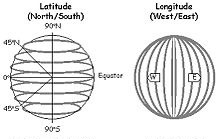
|
| Gaussian distribution | In probability theory, the normal (or Gaussian) distribution is a very common continuous probability distribution.
Normal distributions are important in statistics and are often used in the natural and social sciences to represent
real-valued random variables whose distributions are not known. See:
Normal (Gaussian) distribution from Wikipedia
and Introduction to the normal distribution from Kahn Academy. |
| UTC | Coordiated Universal Time - Time kept by atomic clocks located at time labs around the globe and delivered by the GPS satellites. UTC is five hours ahead of Eastern Standard Time. UTC replaced GMT as the time reference. Times given in UTC are almost always given in terms of a 24-hour clock. Thus, 14:42 (often written simply 1442) is 2:42 p.m., and 21:17 (2117) is 9:17 p.m. United States Naval Observatory. |
| abstract | Abstract: An abstract is a shortened version of the paper and should contain all information necessary for the reader to determine:
1. What the objectives of the study were. 2. How the study was done. 3. What results were obtained. 4. The significance of the results. |
| altitude | Altitude is the vertical elevation distance measured from mean sea level.
Find altitude by:
a) Elevation contours from a topographic map: See topo maps from National Geographic. b) Using a pressure altimeter (an instrument that uses a barometer): See Barometer from TED-Ed. c) Finding elevation of a nearby landmark: See USGS's Geographic Names Information System for online location selection. d) Using a survey quality GPS unit. Inexpensive hand-held units will approximate altitude to within only 100 ft. |
| analysis list | Select Analyses under the Data menu to see your analysis list.
 Analyses are studies you have run in the past 48 hours. You can click on the link in the Analysis column to see the plot you made and save it permanently if you are satisfied with it.  You can always run the analysis again and change the input parameters. Items remain for a maximum of 48 hours with a limit of 80 items per research group. The oldest items get removed first. |
| azimuth | azimuth - an arc of the horizon measured between a fixed point (as true north) and the vertical circle passing through the center of an object
usually in astronomy and navigation clockwise from the north point through 360 degrees.
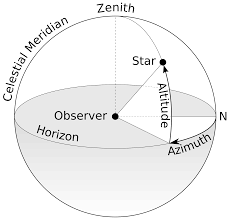
|
| barometric pressure | The pressure force caused by the weight of air above the surface of the Earth.
Usually measured by a barometer and given in units of kPa, inches of Hg, or millibars. 1 Pascal (symbol: Pa) is defined as 1 Newton/square meter.

|
| coincidence | Simultaneous signals which are received within a short time specified by the user. Coincidence level specifies the criteria for a qualifying event written out by the DAQ received from the detector channels. User may specify single, "two-fold," "three-fold," or "four-fold" events. Each, in turn, requires signals in more counters and sets a higher constraint on a qualifying event. |
| cosmic ray | Particle from the cosmos studied by scientists. Galactic Cosmic Rays |
| counter | Each cosmic ray detector has up to four counters. Here are two counters,
each consisting of a scintillator
and photomultiplier tube
connected to the DAQ board.
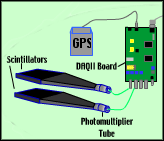
|
| decay | A process in which an original particle (or nucleus) disappears and is replaced by
two or more particles (called decay products). Decays conserve energy, charge and momentum. The summed mass of the decay products is less than the mass of the original. The vector sum of the decay products' momentum must equal the momentum of the original particle. The summed charge of all decay products must equal the charge of the original. |
| detector | The QuarkNet cosmic ray muon detector includes counters,
DAQ board, power supply,
GPS receiver, and cables.
Each detector has up to four counters. Here are two counters,
each consisting of a scintillator
and photomultiplier tube
connected to the DAQ board.
|
| detector id | Every DAQ board has a detector id (DAQ number) based on the serial number on the board. Teachers enter the detector id(s) when they register and students select it when they upload data. To find it, type "SN" when connected with your detector. |
| flux | Rate represents number of particle hits per time. Flux is rate per area.
Typical units to measure flux: number(events)⁄s·m2. |
| geometry | Arrangement of scintillators -
Stacked  are good for flux and lifetime
studies; unstacked are good for flux and lifetime
studies; unstacked  are for
shower studies. are for
shower studies.
Many calculations rely on knowing the detector's location and arrangement. The geometry stores this information and should be uploaded with the data. Here is a typical detector layout. The GPS unit is the 0,0,0 point of a coordinate system. In this example, the GPS unit is on the roof and the counters are inside the classroom.
The counters are arranged in this (x,y,z) coordinate system which our measurements refer to. Our example shows the plane containing the counters to be 4 meters below the plane containing the GPS.
Here is how the geometry is displayed.
|
| grid | A collection of web-connected computers for sharing power and storage resources. For an introduction, see:
The Grid and
The Worldwide LHC Computing Grid.
|
| hexadecimal number |
A number system with a base of 16. The integers are:
Use the form to convert from one to other bases with decimal numbers less than 256: |
| lifetime | The mean time for a particle to decay. Similar to half-life for radioactive nuclei. |
| light leaks | The QuarkNet detectors require a dark environment. Plastic scintillator is mated using optical glue and shaped fittings to PMTs. The scintillators are covered with reflective material (aluminum foil works) and then with black paper and tape to make them "light-tight." |
| metadata | Metadata (meta data, or sometimes metainformation) is "data about other data". The e-Lab stores metadata for the Cosmic Ray data files, plots and posters. Searching metadata is a powerful way to find the data you want. Read more about metadata on Wikipedia. |
| milestone | The color of the dot indicates where on the site you will be working for that milestone (for example, blue dots correspond to the Data section). |
| milestone seminar | |
| milestone seminar text | Take this opportunity to discuss your progress and understanding with your teacher. |
| milestone text | |
| muon | A charged, unstable lepton about 200 times more massive than an electron. |
| photomultiplier tube | Vacuum tube that converts extremely low light levels into electrical signals. Sometimes called a PMT. |
| primary cosmic ray | An energetic particle, usually a proton or heavier nucleus, that is created in stellar processes and travels through space. These can collide with air molecules in Earth's upper atmosphere. The collisions create new, short-lived particles that continue to move toward Earth. These secondaries can also decay into particles; some (e.g., muons) live long enough to reach Earth's surface. |
| pulse | See signal. |
| pulse width | See signal width. |
| rate | The ratio of the number of events during a given length of time: rate = # events / time. Will yield flux when rate is divided by the area of a detector. |
| scintillation light | The light created by a charged particle moving through scintillating plastic. |
| scintillator | A material that gives off light when a charged particle passes through it.
These are typically made of plastic that has been doped with molecules that gain energy from the passing electric field of charged particles. The energy is stored in electron orbitals and then promptly released in the form of light. |
| shower | Primary cosmic rays can interact with nucleons in Earth's upper atmosphere. Showers occur when these primaries are extremley energetic, and produce large numbers of secondary particles (mostly pions and kaons). The secondaries promptly decay into the particles that strike Earth's surface. During a shower, thousands of these particles can strike an area as large as several square kilometers nearly simultaneously. |
| signal | The signal occurs when the photomultipler tube very quickly discharges millions of electrons. This looks like a surge in the voltage in the wire connected to the data acqusition board. The signal has a characteristic shape--sometimes called a pulse--in which the voltage smoothly drops to a low point and then smoothly increases to zero. Depending on the PMT, this signal can last for a few to 50 nanoseconds."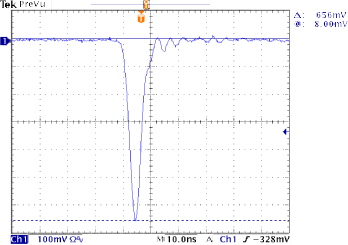
|
| signal width | The signal width, (sometimes called time over threshold), is the total time the signal is "over" a pre-defined threshold value. This graph shows the signal at zero for 3 nanoseconds and then it rapidly goes to about 5.5 negative units. The threshold is at 2.5 negative units. The moment that the signal crosses the threshold, the electronics begin to measure it. While -5.5 is certainly smaller than -2.5, physics jargon still calls this "over threshold." 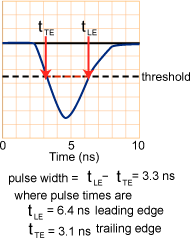
|
| soft triggers | Soft Trigger: Require Channels Allows user to define the exact combination of channels required to be hit in each event, in order to appear in the final TOF histograms. If no channels are selected, the software trigger is ignored. Can be used in combination with Veto. Soft Trigger: Veto Channels Allows user to require that certain channels are NOT present in the events used to create the TOF histograms. For example in data with three live channels (1, 2, and 3), if the user selects channel 3 in Veto Channels and channels 1 and 2 in Require Channels, only events with hits in channels 1 and 2, but not channel 3 are passed to histograms. If no Veto selection is made, events with hits in both channel combinations of 12 and 123 are passed to histograms. |
| solar activity | The Sun provides a constant flux of charged particles. The level of these particles rise and
fall depending on the solar activity. These events result from solar flares.
When the particles reach the Earth they cause aurora, geomagnetic storms, and disruption
of made-made infrastructure such as navigation systems and electrical power grids.
See a primer on space weather from NOAA.
See current solar conditions:
Today's Space Weather. |
| time dilation | The relativistic effect explained by Einstein's Theory that slows the clock of a moving object relative to a stationary observer. Time Dilation |
| time of day | Time of day normally refers to the clock everyone uses. This time is referenced to the Sun and called solar time. However, another standard time reference uses the stars instead of the Sun. This is called sidereal time. |
| time stamp | A time value attached to an event on the data acqusition board (DAQ). The time derives its accuracy from the GPS time signal picked up by the GPS module attached to the DAQ. The time precision is of the order of tens of nanoseconds, and this precision allows the coordination of data during a cosmic ray shower. |

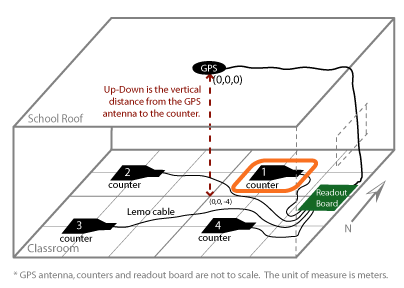
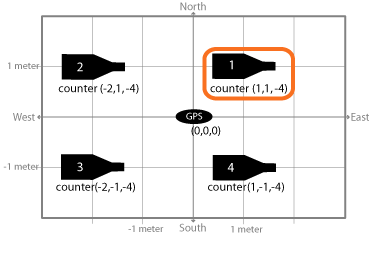
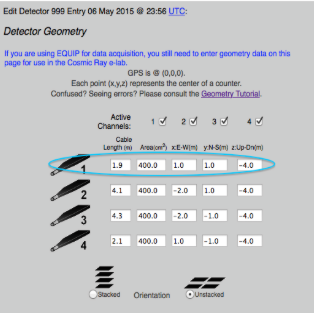
 Scientists have software to plan and track their projects. Our online version includes these milestones with references and a logbook that allow you to plan and track your work.
Scientists have software to plan and track their projects. Our online version includes these milestones with references and a logbook that allow you to plan and track your work. Scientific collaborations hold regular meetings to track progress on their projects. Leaders also schedule impromptu meetings for smaller groups focused on an aspect of the larger project. Teachers may hold milestone seminars to discuss your progress and understanding.
Scientific collaborations hold regular meetings to track progress on their projects. Leaders also schedule impromptu meetings for smaller groups focused on an aspect of the larger project. Teachers may hold milestone seminars to discuss your progress and understanding.
 Scientists have software to plan and track their projects. Our online version includes these milestones with references and a logbook that allow you to plan and track your work.
Scientists have software to plan and track their projects. Our online version includes these milestones with references and a logbook that allow you to plan and track your work.